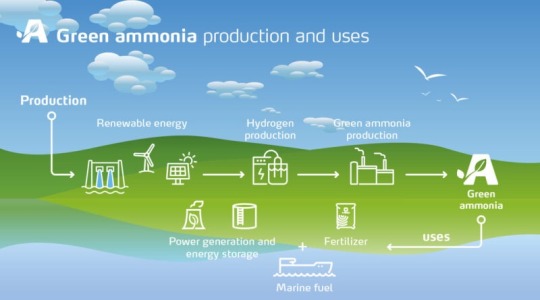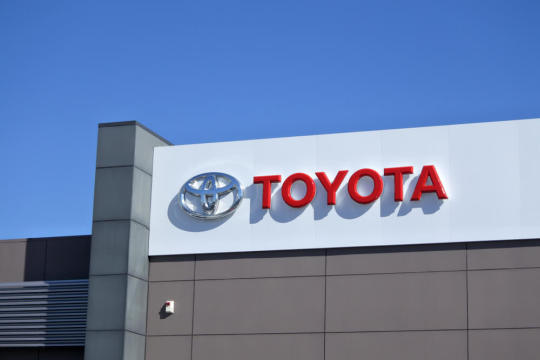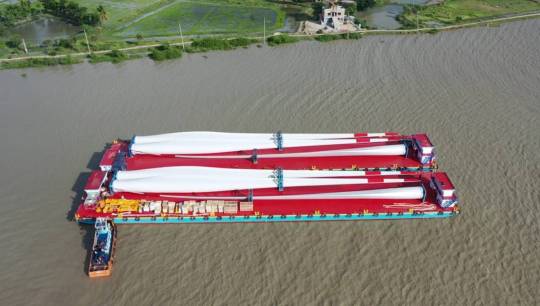#NREL
Text
Green Hydrogen with Green Ammonia Twist + $4 BILLION USD in Investment Support Solidifies Path to Large and Small GH Commercialization
Image: Green ammonia production from green hydrogen courtesy of World Economic Forum.
The debate over green hydrogen continues, but the flow, the deluge of BILLIONS of DOLLARS into new and larger GH projects, solidifies the path to Commercialization for both large and small applications.
In the latest news, the Saudi-listed desalination powerhouse ACWA Power has just added another notch in its…

View On WordPress
#Amonia#Colorado School of Mines#Genesis Nanotechnology#Green Hydrogen#Nanomaterials#Nanotechnology#NREL#Toyota
3 notes
·
View notes
Text
トヨタとNREL、1MWのバックアップ燃料電池を構築へ
トヨタ自動車と米国エネルギー省(DOE)は、最終的に従来の発電機のドロップイン代替となりうる1MWの燃料電池発電システムのプロトタイプの開発に取り組んでいます。
コロラド州アーバダにあるDOEの国立再生可能エネルギー研究所(National Renewable Energy Laboratory:NREL)は、Toyota Motor North Americaと協力し、NRELのFlatironsキャンパスに1MWのプロトン交換膜(PEM)燃料電池発電システムを設置し、評価を行っています。
今回の発表は、マイクロソフトがPlug…

View On WordPress
0 notes
Text
من المختبر إلى السوق.. رحلة الخلايا الشمسية متعددة الوصلات.. كفاءة تزيد عن 40%
عالم الطاقة المتجددة في تطور مستمر، وتكنولوجيا الطاقة الشمسية ليست استثناء.
من أكثر التطورات الواعدة في مجال الطاقة الشمسية ظهور الخلايا الشمسية متعددة الوصلات.
تتمتع هذه الأجهزة المبتكرة بالقدرة على إحداث ثورة في صناعة الطاقة الشمسية من خلال تقديم معدلات كفاءة أعلى بكثير من الخلايا الشمسية التقليدية أحادية الوصلة.
فإن الرحلة من المختبر إلى السوق هي رحلة معقدة وصعبة، مع وجود العديد من العقبات…

View On WordPress
#المختبر الوطني للطاقة المتجددة (NREL)#الولايات المتحدة#الخلايا الشمسية متعددة الوصلات#الطاقة المتجددة#الطاقة الشمسية
0 notes
Text
Wind Energy Projects in Bangladesh: Status and Prospects
Wind Energy Projects in Bangladesh: Status and Prospects
Bangladesh’s power generation from large- and medium-scale wind-run power plants will increase manifold by December next year, as construction works on some of the large projects initiated in the last couple of years are expected to end within the deadline.
While the government plans to implement a dozen wind power projects to generate around 350MW in the next few years, Cox’s Bazar is likely to…

View On WordPress
#carbon emission#Chinese State Power Investment Corporation Limited (SPIC)#climate change#Cox&039;s Bazar#National Renewable Energy Laboratory (NREL)#Renewable Energy#Sustainable And Renewable Energy Development Authority (Sreda)#US-DK Green Energy (BD) Ltd#Wind Power Plant#Windmill
0 notes
Text
The bifacial solar cell, developed at the US Department of Energy’s National Renewable Energy Laboratory (NREL), harvests reflected sunlight hitting the back of the device, offering an unconventional route to producing higher energy yields for less space and cost.
Typical advances to solar cell efficiency rates centre on iterative improvements to the side facing the Sun. This new approach could boost the energy harvesting capabilities of solar panels beyond their theoretical limit.
“This perovskite cell can operate very effectively from either side,” said Kai Zhu, a scientist at the Chemistry and Nanoscience Center at NREL who led the research.
Current solar cell technologies, which use silicon as the semiconductor material, have an efficiency rate of around 26 per cent – higher than the 23 per cent achieved in lab tests by the front side of the new panel.
The back side of the panel, however, achieves an efficiency of about 91-93 per cent of the front, which offers up to 20 per cent more power overall when harvesting reflected sunlight.
249 notes
·
View notes
Text
When turbine blades for the United States’ first offshore wind project left port in September 2023, headed for the Vineyard Wind 1 project off Massachusetts, they were traveling on a barge instead of a wind turbine installation vessel, or WTIV. These purpose-built vessels are common in other parts of the world and make the job much, much easier. A WTIV is a transportation and construction rig in one. Frequently equipped with a big crane, deployable legs, and a dynamic positioning system, WTIVs can support the installation of several humongous turbines per trip.
There are dozens of WTIVs plying the world’s waters. So, why were the Vineyard Wind 1 blades delivered on a barge? This expensive, inefficient workaround was necessary because of a century-old law known as the Jones Act.
Also known as the Merchant Marine Act of 1920, the Jones Act requires anyone transporting goods from one point in the United States to another to use an American ship. And by a modern interpretation of the old law, an offshore turbine counts as a point in the United States. The trouble is, the United States doesn’t have any WTIVs. And without the appropriate equipment, the country’s offshore wind efforts are being plagued by the need for repeated, smaller-capacity barge trips that have added costs to projects already beset by financial difficulties. Danish energy company Ørsted, for example, cited vessel delays when it canceled two planned projects off the New Jersey coast: Ocean Wind 1 and 2.
The country’s first Jones Act–compliant WTIV, the Charybdis, is currently under construction in Texas. While originally planned for completion in 2023, labor constraints have pushed the Charybdis’s launch back at least a year, possibly into 2025, says Dominion Energy, the vessel’s owner.
The Biden administration’s goal is to deploy offshore wind turbines capable of generating 30 gigawatts of power by 2030. That’s more than 2,000 turbines. To meet this target, the National Renewable Energy Laboratory (NREL), part of the US Department of Energy, says there’s a need for four to six WTIVs. But as 2030 draws ever closer, the incomplete Charybdis remains the only one.
The Jones Act is tricky to navigate. For a vessel to be compliant, it must not only be built in the United States and running the country’s flag but also be owned and crewed by Americans. Consequently, US shipyards enjoy a monopoly, which allows them to demand massively inflated prices.
When finished, the 144-meter-long Charybdis will boast over 5,000 square meters of main deck area and accommodate up to 119 people, supported by on-board cabins, mess rooms, and shops, as well as a cinema, gym, and hospital. But the WTIV’s cost has climbed from US $500 million to $625 million. Meanwhile, the major shipyards in South Korea could have built a similar vessel in less time, for less money, and with a more powerful crane.
The reason for the Jones Act’s longevity, says Colin Grabow, a research fellow at the Cato Institute, a libertarian think tank, is that while it tends to benefit only a few people and businesses, the act goes unnoticed because there are many payers sharing the increased costs.
The Jones Act is one in a string of protectionist laws—dating back to the Tariff Act of 1789—designed to bolster US marine industries. The Jones Act’s existence was meant to ensure a ready supply of ships and mariners in case of war. Its authors reasoned that protection from foreign competition would foster that.
“Your average American has no idea that the Jones Act even exists,” Grabow says. “It’s not life-changing for very many people,” he adds. But “all Americans are hurt by the Jones Act.” In this case, that’s by slowing down the United States’ ability to hit its own wind power targets.
Grabow says those most vocal about the law—the people who build, operate, or serve on compliant ships—usually want to keep it in place.
Of course, there’s more going on with the country’s slow rollout of offshore wind power than just a century-old shipping law. It took a slew of factors to sink New Jersey’s planned Ocean Wind installations, says Abraham Silverman, an expert on renewable energy at Columbia University in New York.
Ultimately, says Silverman, rising interest rates, inflation, and other macroeconomic factors caught New Jersey’s projects at their most vulnerable stage, inflating the construction costs after Ørsted had already locked in its financing.
Despite the setbacks, the potential for offshore wind power generation in the United States is massive. The NREL estimates that fixed-bottom offshore wind farms in the country could theoretically generate some 1,500 gigawatts of power—more than the United States is capable of generating today.
There’s a lot the United States can do to make its expansion into offshore wind more efficient. And that’s where the focus needs to be right now, says Matthew Shields, an engineer at NREL specializing in the economics and technology of wind energy.
“Whether we build 15 or 20 or 25 gigawatts of offshore wind by 2030, that probably doesn’t move the needle that much from a climate perspective,” says Shields. But if building those first few turbines sets the country up to then build 100 or 200 gigawatts of offshore wind capacity by 2050, he says, then that makes a difference. “If we have ironed out all these issues and we feel good about our sustainable development moving forward, to me, I think that’s a real win.”
But today, some of the offshore wind industry’s issues stem, inescapably, from the Jones Act. Those inefficiencies mean lost dollars and, perhaps more importantly in the rush toward carbon neutrality, lost time.
6 notes
·
View notes
Photo

ISS experiment to convert waste plastics to upcycled materials during spaceflight
A plastic-degrading enzyme and an engineered bacterial strain have just been launched into space with an important mission: to convert waste plastics to upcycled materials during spaceflight.
Currently orbiting Earth on board the International Space Station (ISS), engineered variants of Pseudomonas putida and the PETase enzyme are part of an experiment to see how biological plastic degradation and upcycling performs in low Earth orbit. And the experiment will proceed entirely on its own in a custom payload designed for autonomous cultivation and sampling.
The experiment involves collaboration with MIT Media Lab Space Exploration Initiative, Harvard Medical School, and Seed Health, and is funded in part by the National Renewable Energy Laboratory (NREL)-led Bio-Optimized Technologies to keep Thermoplastics out of Landfills and the Environment (BOTTLE) Consortium, which is sponsored by the Department of Energy's Bioenergy Technologies Office and Advanced Materials and Manufacturing Technologies Office. BOTTLE researchers from NREL working on this project include synthetic biologist Allison Werner, biochemists Erika Erickson and Natasha Murphy, analytical chemists Kelsey Ramirez and Morgan Ingraham, and BOTTLE CEO Gregg Beckham.
Read more.
#Materials Science#Science#Plastics#Polymers#Space#ISS#Enzymes#Waste#Recycling#Polyethylene terephthalate
24 notes
·
View notes
Text
Optimizing Your Solar System Year-Round
As the Earth tilts and turns, the changing seasons can have a profound effect on the performance of solar power systems. From the height of summer to the depths of winter, a solar panel owner’s strategy must adapt to ensure their system is optimized throughout the year. Let's take a closer look into how each season affects solar output and how you can maximize your system's efficiency, regardless of the weather.
Summer: Sun’s Out, Panels Out
Summer often means longer days and more direct sunlight, which is excellent news for solar energy production. In the United States, the average solar panel efficiency can climb during these months due to increased insolation – a term that refers to the amount of solar radiation reaching a given area. The Solar Energy Industries Association (SEIA) reports that in peak summer, a well-positioned solar panel system can produce twice as much energy as during winter. However, extreme heat can sometimes decrease panel efficiency, a phenomenon known as temperature coefficient, typically resulting in a performance drop of about 0.5% for every 1°C above 25°C.
Fall: Preparing for the Pivot
As fall approaches, the sun’s angle begins to lower, and days get shorter, which can lead to a decrease in solar production. Despite this, cooler temperatures can enhance panel efficiency, slightly offsetting the loss from reduced daylight. It’s essential to prepare for leaf fall during this season, as debris can obstruct panels and impact performance. A National Renewable Energy Laboratory (NREL) study suggests that a single leaf on a panel can reduce power output by up to 10%.
Winter: Weathering the Cold
Contrary to what many assume, solar panels don't go dormant in winter. They can still produce significant energy, especially in areas with strong winter sunlight. Snow can even act like a mirror, reflecting light and potentially increasing performance on clear days. The key statistic to watch, however, is daylight hours. For instance, according to the U.S. Energy Information Administration (EIA), regions like the Pacific Northwest see a reduction of about 40% in solar radiation from November through February, affecting potential output.
Spring: A Time for Tune-Ups
Spring is often seen as a time of renewal, and for solar panel systems, it's an ideal period for maintenance to optimize energy capture. As days lengthen, your solar system's production will naturally increase. To fully capitalize on this, ensure your system is free from the winter’s accumulation of dirt and debris. Data from the Department of Energy indicates that a clean solar panel is approximately 21% more efficient than one covered in the season’s grime.
Year-Round Maintenance and Monitoring
Regular maintenance is crucial for keeping your solar power system at peak performance. It’s advisable to check your system's output against benchmarks provided by your installer or local averages. Most modern systems come with apps or monitoring software, enabling you to track energy production in real-time and notice any significant discrepancies that may indicate an issue.
Utilizing Battery Storage
To truly optimize your system year-round, consider integrating battery storage. This allows you to capture excess energy during peak production times and use it when the sun isn’t shining. For example, Tesla’s Powerwall reports that, when used effectively, battery storage can increase the self-consumption of solar power from 30% to upwards of 70%.
Embracing Energy Efficiency
Lastly, optimizing a solar system isn’t just about maximizing production; it’s also about minimizing consumption. Implementing energy efficiency measures within your home can significantly impact how much solar power you need to meet your energy demands. The EPA suggests that for every kilowatt-hour of solar energy used efficiently, a typical system’s return on investment can improve by 5-10%.
By understanding and adapting to the seasonal shifts in solar production, you can ensure your system is not only effective but also contributes to a sustainable future all year round. Whether you’re dealing with the abundance of summer sun or the scarcity of winter light, these strategies will help you stay powered through every season.
#solarpanels#solar#solarenergy#photovoltaics#solartechnology#renewables#sustainability#greenenergy#cleanenergy#residentialsolar#solarathome#energyefficiency#solarroi
4 notes
·
View notes
Text
Dziekuje osobom ktore mnje wyzywaja od emosow za ego-boost

1 note
·
View note
Text
youtube
You shouldn't believe everything you see on the internet. Particularly when it comes to renewable energy. We started debunking some of the biggest myths about wind and solar energy – and ended up in a world of shady lobby groups and secret money streams. Come follow us down the rabbit hole.
Credits
Reporter: Malte Rohwer-Kahlmann
Video Editor: Markus Mörtz
Supervising Editor: Joanna Gottschalk, Michael Trobridge, Kiyo Dörrer
Factcheck: Kirsten Funck
Thumbnail: Em Chabridon
We're destroying our environment at an alarming rate. But it doesn't need to be this way. Our new channel Planet A explores the shift towards an eco-friendly world — and challenges our ideas about what dealing with climate change means. We look at the big and the small: What we can do and how the system needs to change. Every Friday we'll take a truly global look at how to get us out of this mess.
#PlanetA #RenewableEnergy #Disinformation
Read more:
NREL's life cycle assessment of electricity generation technologies:
https://www.nrel.gov/docs/fy21osti/80...
University of Texas snowstorm report: https://energy.utexas.edu/sites/defau...
Hidden resilience and adaptive dynamics of the global online hate ecology:
https://www.nature.com/articles/s4158...
Obstructing action: foundation funding and US climate change counter-movement organizations: https://cssn.org/wp-content/uploads/2...
The Debunking Handbook: https://www.climatechangecommunicatio...
Chapters:
00:00 Intro
00:51 What we did
01:58 Emission myths
03:55 Texas snowstorm fiasco
06:11 The misinformation cooking pot
08:34 Cui bono?
#dw planet a#solarpunk#solar energy#wind energy#clean energy#green energy#renewable energy#fossil fuels#myths#debunking#Emission myths#texas#texas snowstorm#USA#smear tactics#misinformation#Auke Hoekstra#Paulina Jaramillo#Mark Jacobson#Youtube
3 notes
·
View notes
Text
Sirius was a gifted pianist and could have gone pro. He also speaks french. So I can see him playing this song when he's in emotional turmoil.
Ne Me Quitte Pas by Jacques Nrel
(Translated lyrics, not all of them, I don't speak french nor understand it so accuracy is not guaranteed and can be phrased differently.)
Do not leave me now
We must just forget
Yes, we can forget
All that’s flown beyond
Let’s forget the time
The misunderstands
And the wasted time
To find out how
To forget these hours
Which sometimes kill
The blows of why,
A heart full of joy.
Do not leave me now
Do not leave me now
Do not leave me now
Do not leave me now
https://open.spotify.com/track/6IRA4KOVbtiGiTdYoEThJN?si=8b256796a50f4bd3
2 notes
·
View notes
Text
Five Questions to Ask Before Installing Solar Panels
Solar panels have acquired immense popularity all across the globe. Why wouldn’t anyone want to take advantage of the sun – a free, abundant, and renewable source of energy, right? Because they believe that installing solar panels is a challenging task. You must consider the initial expense as well as choose the right type of solar panel for your house. Below are a couple of questions to ask before making the investment. Please check them out.
How Solar Panels Work?
The experts providing high-quality solar panels Adelaide said solar panels convert sunlight to create energy. They are usually found on the rooftops but people can install them practically anywhere in the house. The energy created by the panels must first be stored inside a dedicated battery and then used. The energy can also be sent back to the primary electric grid.
Is Your Roof Ideal for Solar Panels?
A damaged or old roof cannot endure the weight of the panels. Before purchasing solar panels, please get your roof professionally inspected. Make the necessary repairs. At least, get new shingles or else the whole grid will have to be removed in future. What should you do if a roof is completely ruined? Go ahead and place the panels in the backyard. Allow the panels to absorb substantial amounts of sunlight.
What are the Different Types of Solar Panels?
According to the experts offering top-notch Adelaide solar panels, the three types of solar panels available on the market are – monocrystalline, polycrystalline and thin film. Monocrystalline panels are what you see in most residential properties. Even though the price is on the higher side, these panels are most efficient. Polycrystalline panels are a bit less efficient but they do not cost that much. Thin film panels have a fine design. They are portable and flexible too.
What is the Difference between Solar Panels and Solar Shingles?
Most people get confused between solar panels and solar shingles. The former is traditional and does not cost much. The latter, on the other hand, are relatively new. They sit on top of the roof and look visually appealing. However, solar shingles are a tad more expensive than panels.
Do You Need Permits for Installing Solar Panels?
When it comes to solar panels, every state and municipality has its own set of regulations. You may need a permit to install the panels. Ask your local authority. Depending on what you are opting for, you may have to wait to get the approval. Before choosing and buying solar panels, please get the formalities sorted first.
Once you get solar panels hooked up, you will be able to reduce the electricity bills in a seamless manner and add value to your entire house. The experts providing solar panels South Australia say that with time, dirt, dust, and debris will accumulate on top of the panels, which will degrade their performance. In fact, according to the NREL, soiling contributes to 7.5% of energy loss. Make sure to clean your solar panels so they can operate at optimal efficiency.
#solar south Australia#South Australia solar#Adelaide solar systems#solar systems Adelaide#solar companies Adelaide#Adelaide solar installers
2 notes
·
View notes
Photo

Ученые создали ИИ для анализа влияния изменения климата на энергетику
Ученые Национальной лаборатории возобновляемой энергии (NREL) разработали новую модель Sup3rCC, которая значительно повышает доступность данных о климате и возобновляемых источниках энергии высокого разрешения. Эта модель, основанная на машинном обучении, ускоряет процесс генерации данных о климатических изменениях и их воздействии на ветровую и солнечную генерацию энергии.
Подробнее на https://7ooo.ru/group/2024/04/11/581-uchenye-sozdaliii-dlya-analiza-vliyaniya-izmeneniya-klimata-naenergetiku-grss-298316927.html
0 notes
Text
The total eclipse shows us how important solar energy is to the US - The Verge
The total eclipse shows us how important solar energy is to the US The Verge
NREL Shows Live Grid Impacts From Total Solar Eclipse NREL
US energy output dips by 30 gigawatts during total solar eclipse The Times of India
Brought to you by Google News. Read the rest of the article here
View On WordPress
0 notes
Text
NREL finds 100% renewable scenario improves LA air quality and health
Read the full story at PV Magazine.
NREL models show that LA and surround counties could save over $4 billion from improved health outcomes. The most significant reductions in emissions resulted from electrification and infrastructural changes to the non-power sector, such as transportation and buildings.
View On WordPress
0 notes
Text
NREL updates online tool with data for Africa, Eastern Europe, Middle East
The US Department of Energy’s National Renewable Energy Laboratory (NREL) has added a high-resolution solar data set covering Africa, Eastern Europe and the Middle East on its Renewable Energy Data Explorer tool.
March 27, 2024 Patrick Jowett
NREL has released a new high-resolution solar data set on its publicly available geospatial analysis tool, the Renewable Energy Data Explorer. It covers…
View On WordPress
0 notes